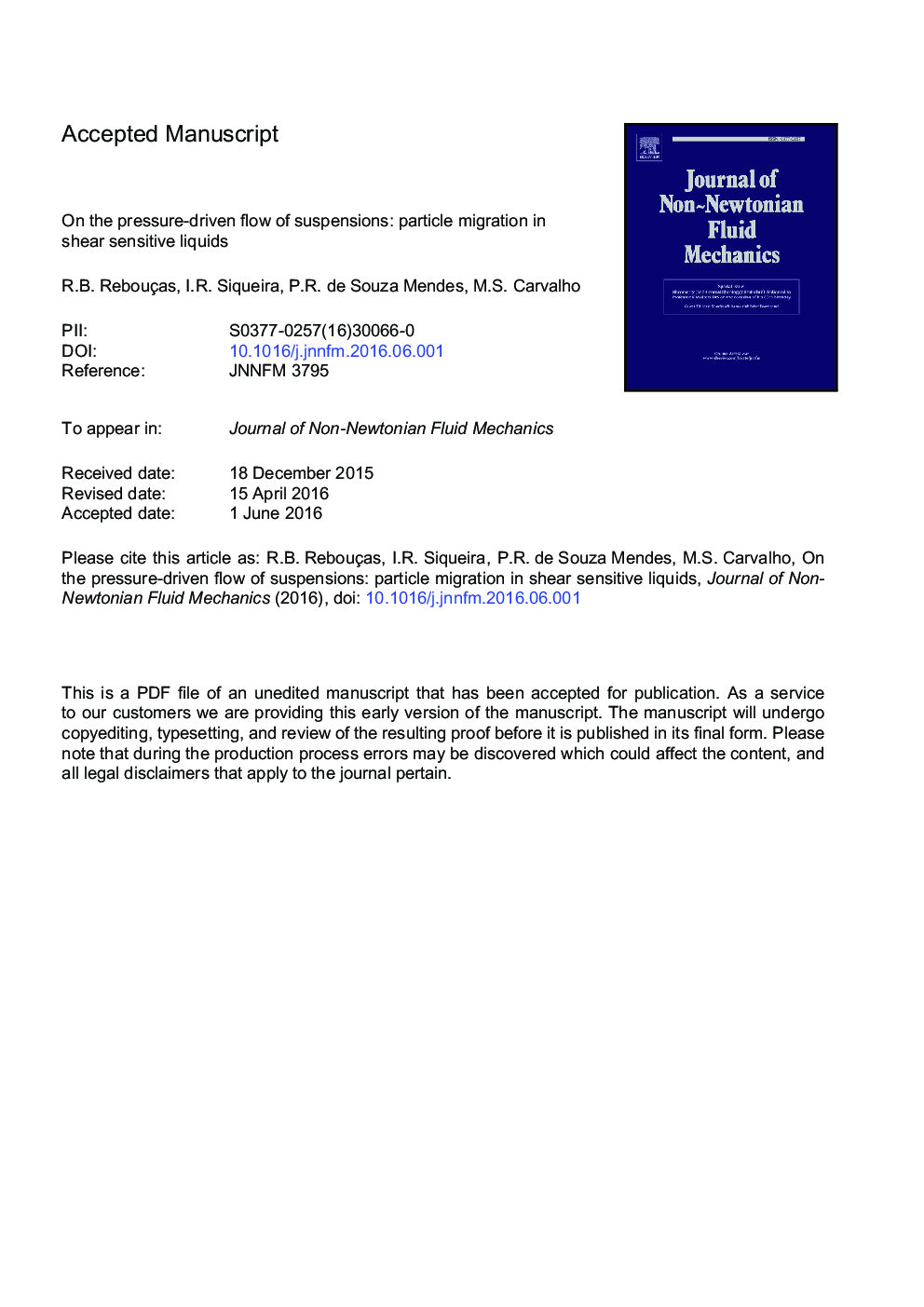| کد مقاله | کد نشریه | سال انتشار | مقاله انگلیسی | نسخه تمام متن |
|---|---|---|---|---|
| 7061159 | 1459006 | 2016 | 36 صفحه PDF | دانلود رایگان |
عنوان انگلیسی مقاله ISI
On the pressure-driven flow of suspensions: Particle migration in shear sensitive liquids
ترجمه فارسی عنوان
در جریان جابه جایی سوسپانسیون تحت فشار: مهاجرت ذرات در مایعات حساس برشی
دانلود مقاله + سفارش ترجمه
دانلود مقاله ISI انگلیسی
رایگان برای ایرانیان
کلمات کلیدی
تعلیق کلوئیدی، جریان تحت فشار تحت فشار، مهاجرت ذرات، ویسکوزیته حساسیت برشی،
ترجمه چکیده
درک پایه ای از جریان تعلیق در بسیاری از زمینه های مختلف مانند مهندسی زیست شناسی، صنایع نفت، غذا، داروسازی و لوازم آرایشی بهداشتی است. دو پدیده مهم ممکن است در جریان تعلیق ذرات رخ دهد. اولین بار با فرآیند آرام سازی ذرات به سمت حالت استراحت پس از جریان متوقف شده است که منجر به حساسیت برشی به ویسکوزیته می شود. دومین ارتباط با ذرات ذره ای است که منجر به مهاجرت ذرات ناشی از برش می شود. شدت هر یک از این اثرات به طور مستقیم با اندازه ذرات و میزان تغییر شکل تحمیل شده مرتبط است. تجزیه و تحلیل های موجود معمولا به یکی از این پدیده ها محدود می شود. یک رویکرد رایج در نظر گرفتن این است که ویسکوزیته تعلیق با سرعت برشی متفاوت است، با استفاده از تابع ویسکوزیته برای توصیف این وابستگی و غلظت ذرات در طول جریان یکنواخت است. اغلب مطالعاتی که در مورد مهاجرت ذرات ناشی از برش در نظر می گیرند، فرض می کنند که ویسکوزیته تنها با غلظت ذرات محلول متفاوت است و عملکرد نرخ برشی نیست. محدوده اعتبار و دقت این دو رویکرد به خوبی قابل درک نیست. در این کار، ما جریان جریان کامل سوسپانسیون ذرات در یک لوله را با استفاده از مدل های مختلف جریان برای بررسی اثر هر دو مایع ذرات و ویسکوزیته وابسته به برش بررسی می کنیم. نتایج نشان می دهد که در شرایط خاص، پیش بینی دقیق نسبت گرادیان جریان جریان-فشار فقط می تواند با توجه به هر دو پدیده در یک مدل جریان کاملا غیرمجاز و غیر خطی ساخته شود.
موضوعات مرتبط
مهندسی و علوم پایه
مهندسی شیمی
جریان سیال و فرایندهای انتقال
چکیده انگلیسی
Fundamental understanding of flow of suspensions is key in many different areas such as bioengineering, oil, food, pharmaceutical and cosmetic industries. Two important phenomena may occur in the flow of particle suspensions. The first is associated with the relaxation process of particles toward a rest state after the flow is stopped that leads to shear-sensitive viscosity. The second is associated with particle-particle interaction that leads to shear-induced particle migration. The intensity of each of these effects is directly associated with particle size and imposed deformation rate. The available analyses are usually limited to one of these phenomena. A common approach is to consider that the suspension viscosity varies with shear rate, using a viscosity function to describe this dependency, and that the particle concentration is uniform throughout the flow. Most of the studies that consider shear-induced particle migration assume that the viscosity varies only with the local particle concentration and is not a function of shear rate. The range of validity and accuracy of these two approaches is not well understood. In this work, we analyze the fully-developed flow of particle suspensions in a tube using different flow models to evaluate the effect of both particle migration and shear dependent viscosity. The results show that, at certain conditions, accurate predictions on the flow rate-pressure gradient relation can only be made by considering both phenomena in a fully coupled, non-linear flow model.
ناشر
Database: Elsevier - ScienceDirect (ساینس دایرکت)
Journal: Journal of Non-Newtonian Fluid Mechanics - Volume 234, August 2016, Pages 178-187
Journal: Journal of Non-Newtonian Fluid Mechanics - Volume 234, August 2016, Pages 178-187
نویسندگان
R.B. Rebouças, I.R. Siqueira, P.R. de Souza Mendes, M.S. Carvalho,
